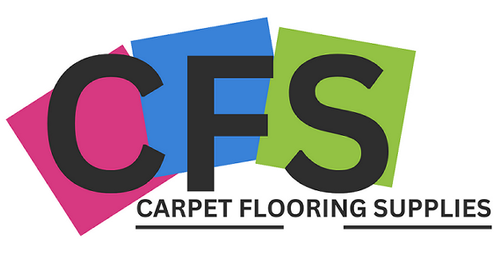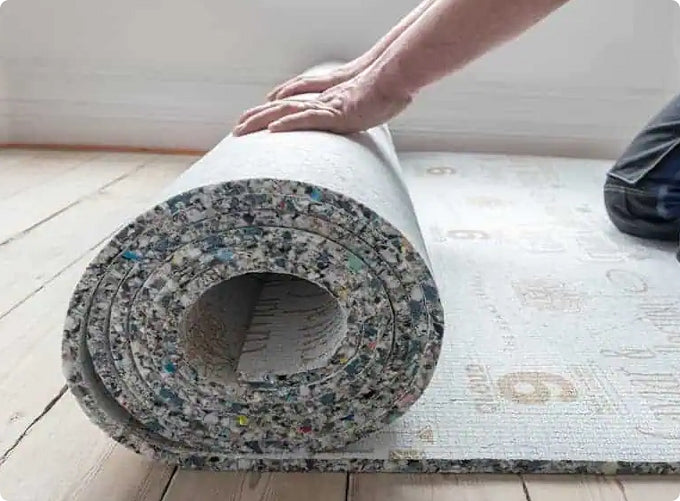When choosing a new carpet underlay, there are various factors to consider. You should take the location of the underlay into account as well as the amount of foot traffic it's likely to get. High-traffic areas like stairs have different requirements than bedrooms, so you should consider the thickness of the underlay, the tog rating, and the amount of noise reduction your room needs.
Underlay Location and Foot Traffic
The location of your new carpet should determine the type of underlay you decide to use.
All of our carpet underlays can be used anywhere throughout the home, but some underlays are better suited to a particular room than others.
Of course, if you’re re-carpeting multiple rooms, or your whole home, ordering different types of underlay for each room isn't the most cost-effective thing to do.
In this case we suggest going for a great all-round underlay that features a good combination of density and thickness, as well as high sound reduction and heat-retaining characteristics.
| Bestselling All-Round Underlays | |

Tredaire Ambiance 9mm Underlay |

Cloud 9 Super Contract 10mm Underlay |

Tredaire Sensation 11mm Underlay |

Wilsons Plushwalk 12mm Underlay |
Thickness
One of the main reasons to choose a new underlay is increased underfoot comfort. As a general rule, the thicker the underlay, the more luxurious it is underfoot.
So if comfort is your main priority, you want a 10-12mm thick underlay.
For a firmer underfoot feel, which you may want on stairs and in heavy traffic areas, a high-density underlay is what you want, many of which are actually lower in thickness.
Stairs, Hallways, Landings and High Traffic Areas
Stairs and hallways are the areas of your home that tend to see the most foot traffic, so your choice of underlay is important.
Any underlay will do the job of cushioning your stair carpet, but we recommend one with a density of at least 105kg/m3 to help with bounce-back and for extra resistance to flattening.
Thin and dense underlays tend to be the most popular for use on stairs, with high-density PU foam underlays and crumb rubber and sponge rubber underlays all being eminently suitable.
| Bestselling Underlays For Stairs | |

Tredaire Softwalk 9mm Underlay |

Cloud 9 Cirrus 9mm Underlay |

Tredaire Dynamics 9.4mm Underlay |

Tredaire Treadmore 7.95mm Underlay |
Lounges, Bedrooms, Dining Rooms and Low Traffic Areas
Rooms designed for comfort and relaxation, such as lounges and bedrooms, don't usually get the same foot traffic as stairs, so you can go for a thicker, more luxurious underlay, allowing you to choose something purely for the comfort factor.
A high-quality PU foam underlay at least 10mm thick is a good choice; they tend to be softer and more comfortable than thinner options and offer decent thermal ratings and sound reduction characteristics.
In very busy lounges, with a lot of foot traffic, you may want to consider a high-density PU foam underlay or even a denser sponge rubber underlay.
If you have heavy furniture and are worried about indentation marks, then a dense crumb rubber underlay is the preferred option; they tend to have the best recovery rates.
| Bestselling Luxury Underlays | |

Tredaire Dreamwalk 11mm Underlay |

Cloud 9 Cumulus 11mm Underlay |

Tredaire Colours Red 11.4mm Underlay |

Wilsons Plushwalk 12mm Underlay |
Tog Rating
An underlay tog rating works much the same way a duvet tog rating does. The higher the tog, the better the underlay is at insulating your room and retaining heat.
Underlays with a low tog (1.0 and under) allow heat to more easily pass through, so they are best used with underfloor heating systems.
Underlays with a higher tog (2.0 and above) are better at insulating your room and retaining heat. These types of underlay are often called thermal underlay and are the ones with the broadest appeal.
If you are trying to keep your energy bills down (and who isn't these days?), take a look at our thermal underlay collection.
| Bestselling Thermal Underlays | |

QA Floorsure Gold 10mm Underlay |

Regal 12mm Underlay |

Gamma 11mm Underlay |

Tredaire Citra 11mm Underlay |
Sound Reduction
Walking around and moving things in upstairs rooms can generate quite a lot of noise that can transmit through the floor, so this is an important issue to try and mitigate.
Every underlay features an impact sound reduction rating; this is measured in decibels (dB) and gives you an idea of how effective an underlay is at reducing transmitted sound.
The higher the decibel rating, the better an underlay is at successfully reducing noise from transmitting through the floor.
We have put together a collection of acoustic underlays to make things easier for you.
Featuring a minimum of 38dB on the impact sound reduction rating, they will help keep the noise down.
| Bestselling Acoustic Underlays | |

Cosi 10mm Underlay |

Tredaire Colours Green 10.3mm Underlay |

Wilsons Plushwalk 10mm Underlay |

Renu Yellow 11mm Underlay |
Underfloor Heating Underlay
If you have an underfloor heating system, you should be selecting a carpet and underlay that both have a low tog. Ideally, a combined tog rating of less than 2.5.
If the combined tog is too high then heat will be trapped underneath your carpet, which is the opposite of what you want, and will result in you just wasting your money.
Our underfloor heating underlays all feature a low tog rating and are designed to get the best out of your heating system, allowing heat to pass through more easily compared to normal underlays.
| Bestselling Underfloor Heating Underlays | |

Duralay Heatflow 6.1mm Underlay |

Tredaire King 8.3mm Underlay |

Tredaire Defender 6.1mm Underlay |

Wilsons ThermalStream 10mm Underlay |
Carpet Type
Short pile and tight loop carpets are known for their durability, and are great for busy households, but one of the downsides to a thin carpet is they can be firm and lacking in comfort.
One of the best ways to get around that, is to pair it with a thicker, more luxurious underlay to improve underfoot comfort.
Thicker carpets with deeper piles, already have a certain amount of built-in comfort to them, but that can come at the expanse of durability, especially if it's a loose pile.
To get the best out of your thicker carpet, you should consider a high density underlay to add some much needed support, this will help prevent it from flattening too quickly.
Natural floor coverings like sisal and seagrass need to be fitted using the double-stick method.
This is required, as natural flooring will expand and contract with fluctuations in temperature, and glueing twice helps reduce this movement.
As you need to glue the underlay to the subfloor, and then the carpet to the underlay, (hence the term double-stick) not all underlays are suitable for this installation method.
You will need to find an underlay that is suitable for double stick installations.
Finally, you should take the combined underlay and carpet height into account when it comes to your door frames.
If you go too thick, then the combined height may be too much, and you may need a joiner to trim and rehang your doors.
Still Need Help?
If you are still unsure what would be the best underlay for your needs, we are happy to answer any of your questions, simply get in touch and we'll be happy to help.

